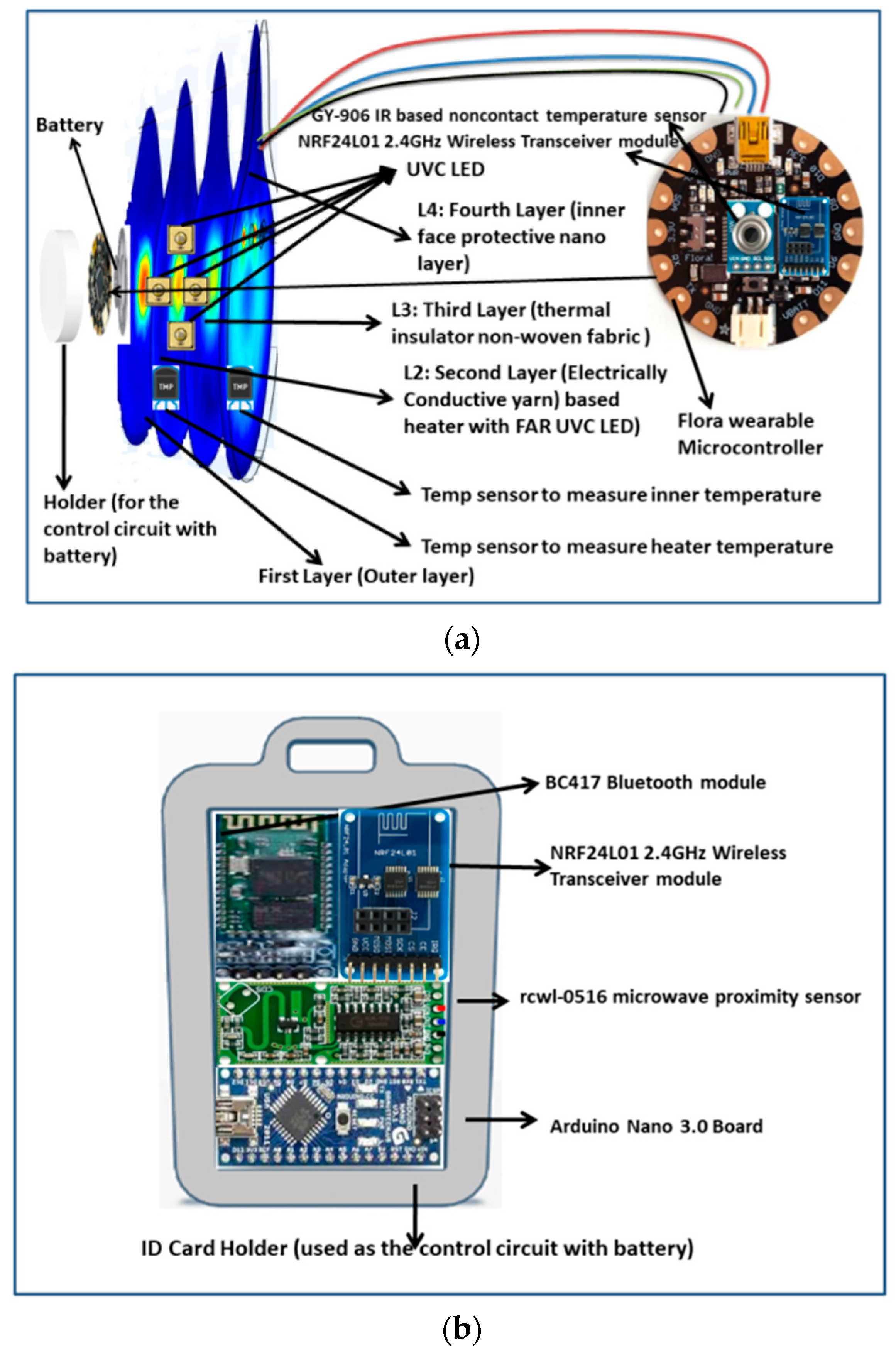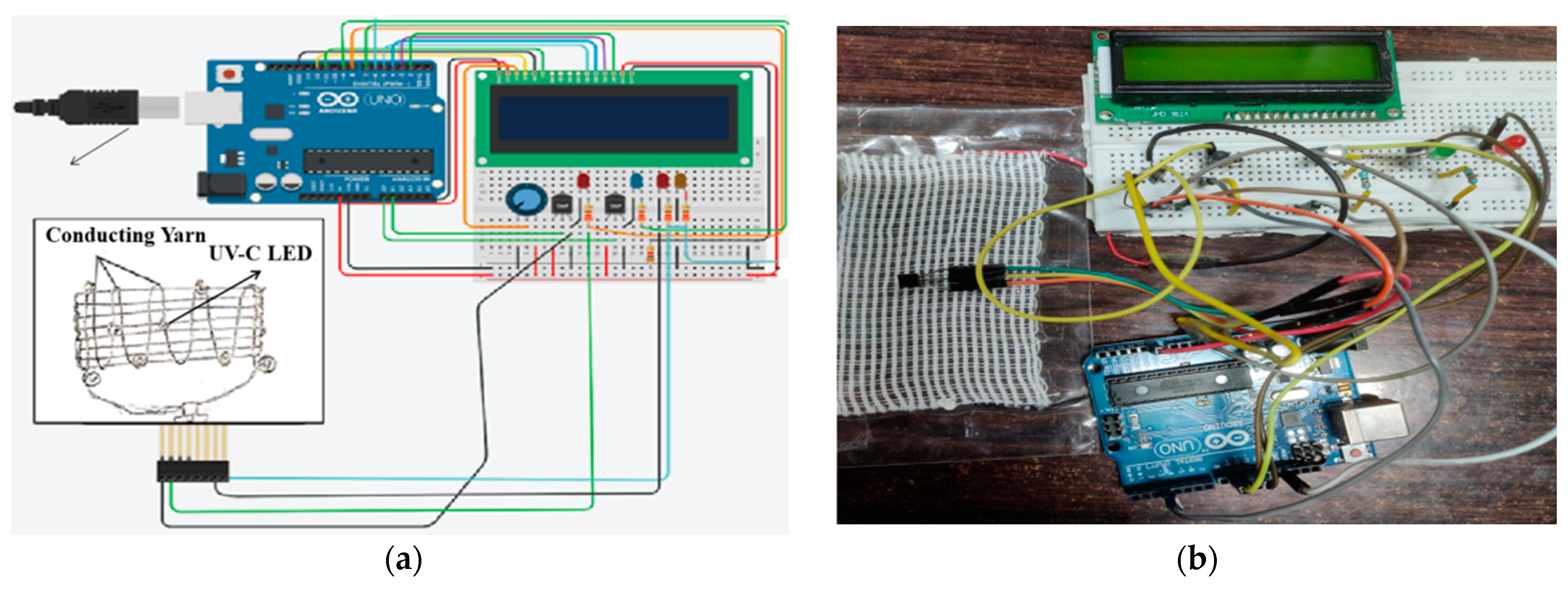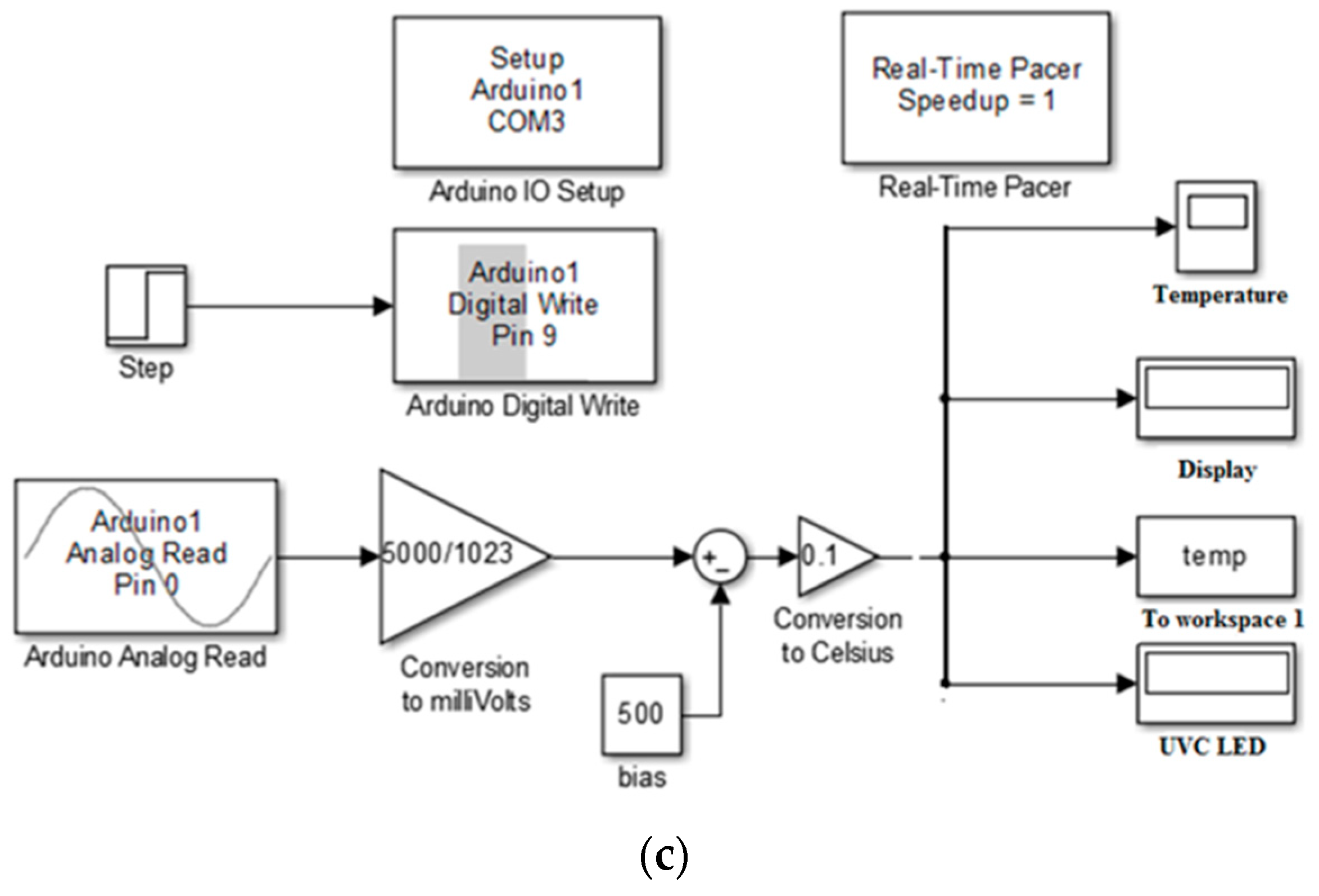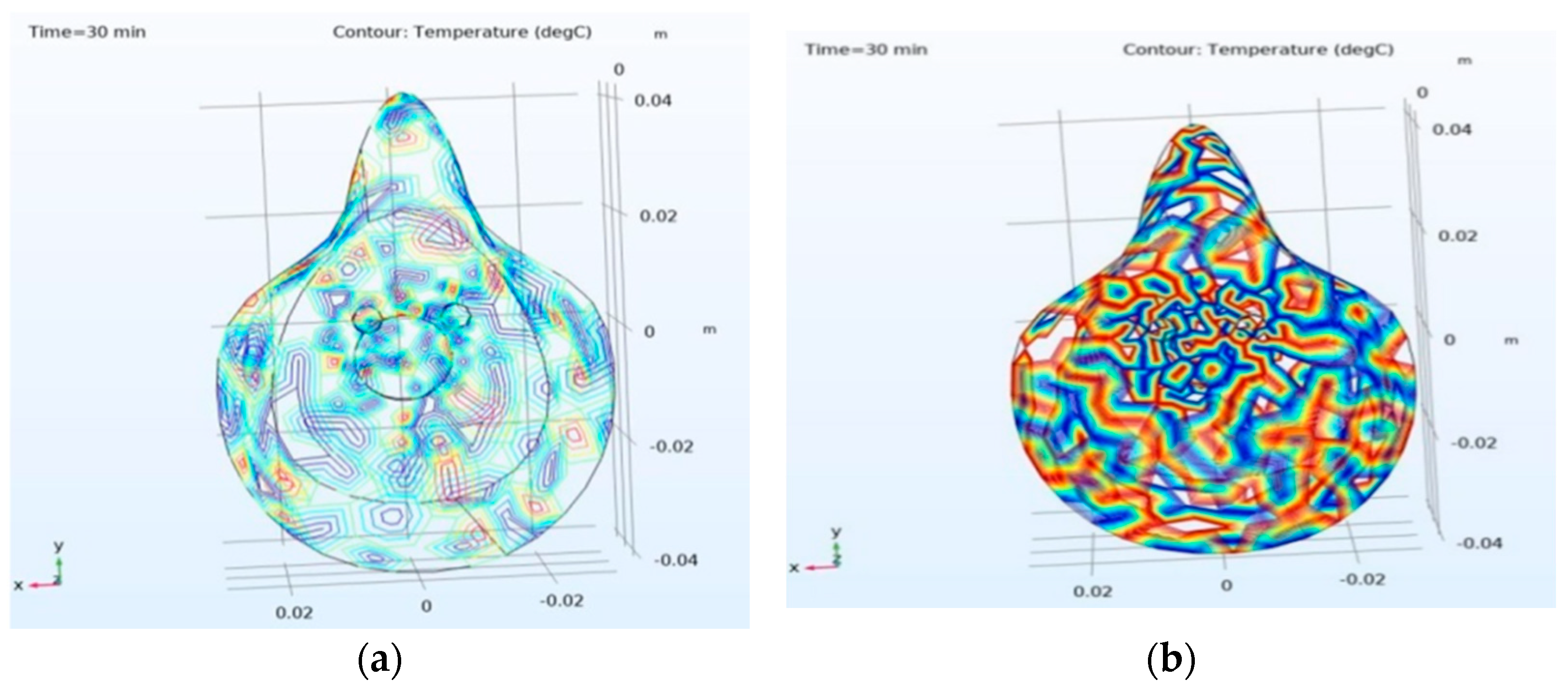UVC LED and Conducting Yarn-Based Heater for a Smart Germicidal Face Mask to Protect against Airborne Viruses
Abstract
:1. Introduction
2. Technological Advancement
2.1. Proposed Design with Material Details
2.2. Controlling Circuit Detail
3. Results
3.1. Safety and Efficiency of the Proposed Mask with Respect to Temperature
3.2. Safety and Efficiency of the Proposed with Respect to UV-C LED
3.3. Bacterial Filtration Efficiency (BFE)
- Biological Aerosol: Staphylococcus aureus;
- Area contacting with the bacterial Challenge: Inside the mask;
- Mean particle size of the challenge Aerosol: 3 µm ± 0.3 µm;
- Test Area: 50 cm2 Approx.
3.4. Moisture Management Tests (MMT), Antibacterial and Cytotoxicity Analysis
4. Conclusions
Author Contributions
Funding
Institutional Review Board Statement
Informed Consent Statement
Data Availability Statement
Conflicts of Interest
References
- Brain, J.D.; A Valberg, P. Deposition of aerosol in the respiratory tract. Am. Rev. Respir. Dis. 1979, 120, 1325–1373. [Google Scholar] [CrossRef] [PubMed]
- Barro, R.J.; Ursúa, J.F.; Weng, J. The Coronavirus and the Great Influenza Pandemic: Lessons from the “Spanish Flu” for the Coronavirus’s Potential Effects on Mortality and Economic Activity; 0898-2937; National Bureau of Economic Research: Cambridge, MA, USA, 2020. [Google Scholar]
- Coronavirus Update (Live): 96,095,456 Cases and 2,051,742 Deaths from COVID-19 Virus Pandemic—Worldometer. Available online: https://www.worldometers.info/coronavirus/ (accessed on 6 October 2020).
- Watkins, J. Preventing a COVID-19 pandemic. BMJ 2020, 368, m810. [Google Scholar] [CrossRef] [PubMed] [Green Version]
- Gardner, P.D.; Eshbaugh, J.P.; Harpest, S.D.; Richardson, A.W.; Hofacre, K.C. Viable Viral Efficiency of N95 and P100 Respirator Filters at Constant and Cyclic Flow. J. Occup. Environ. Hyg. 2013, 10, 564–572. [Google Scholar] [CrossRef] [PubMed]
- Amichay, R.; Harash, R.; Ayyub, R.; Heller, J.; Kasolowsky, R. Self-Cleaning Mask Can Kill Viruses with Heat from Phone Charger, Researchers Say. Reuters. 2020. Available online: https://uk.reuters.com/article/uk-health-coronavirus-israel-mask/self-cleaning-mask-can-kill-viruses-with-heat-from-phone-charger-researchers-say-idUKKBN23O11J (accessed on 4 October 2020).
- Shi, J.; Liu, S.; Zhang, L.; Yang, B.; Shu, L.; Yang, Y.; Ren, M.; Wang, Y.; Chen, J.; Chen, W.; et al. Smart Textile-Integrated Microelectronic Systems for Wearable Applications. Adv. Mater. 2019, 32, e1901958. [Google Scholar] [CrossRef] [PubMed]
- Ismar, E.; Bahadir, S.K.; Kalaoglu, F.; Koncar, V. Futuristic Clothes: Electronic Textiles and Wearable Technologies. Glob. Chall. 2020, 4, 1900092. [Google Scholar] [CrossRef] [PubMed] [Green Version]
- Beck, S.E.; Rodriguez, R.A.; Hawkins, M.A.; Hargy, T.M.; Larason, T.C.; Linden, K.G. Comparison of UV-Induced Inactivation and RNA Damage in MS2 Phage across the Germicidal UV Spectrum. Appl. Environ. Microbiol. 2016, 82, 1468–1474. [Google Scholar] [CrossRef] [PubMed] [Green Version]
- Sabino, C.P.; Ball, A.R.; Baptista, M.S.; Dai, T.; Hamblin, M.R.; Ribeiro, M.; Santos, A.L.; Sellera, F.P.; Tegos, G.P.; Wainwright, M. Light-based technologies for management of COVID-19 pandemic crisis. J. Photochem. Photobiol. B Biol. 2020, 212, 111999. [Google Scholar] [CrossRef]
- Pendyala, B.; Patras, A.; Pokharel, B.; D’Souza, D. Genomic Modeling as an Approach to Identify Surrogates for Use in Experimental Validation of SARS-CoV-2 and HuNoV Inactivation by UV-C Treatment. Front. Microbiol. 2020, 11, 572331. [Google Scholar] [CrossRef] [PubMed]
- World’s First Antiviral Face Mask with Active UV-C Sterilizing Makes It Easy to Breathe 99% Clean Air. Yanko Design. Available online: https://www.yankodesign.com/2020/07/18/worlds-first-antiviral-face-mask-with-active-uv-c-sterilizing-makes-it-easy-to-breathe-99-clean-air/ (accessed on 4 October 2020).
- Oracle Lighting Develops COVID-19/Virus Neutralizing UV-Light Face Mask for Consumer/Medical Use—TWICE. Available online: https://www.twice.com/the-wire/oracle-lighting-develops-covid-19-virus-neutralizing-uv-light-face-mask-for-consumer-medical-use (accessed on 4 October 2020).
- Ludwig-Begall, L.F.; Wielick, C.; Dams, L.; Nauwynck, H.; Demeuldre, P.F.; Napp, A.; Laperre, J.; Haubruge, E.; Thiry, E. The use of germicidal ultraviolet light, vaporised hydrogen peroxide and dry heat to decontaminate face masks and filtering respirators contaminated with a SARS-CoV-2 surrogate virus. J. Hosp. Infect. 2020, 106, 577–584. [Google Scholar] [CrossRef]
- Khandual, A.; Rout, N.; Verma, S.; Patel, P.; Pattanaik, P.; Luximon, Y.; Kumar, A.; Nayak, R.; Suar, M. Controlled nano-particle dyeing of cotton can ensure low cytotoxicity risk with multi-functional property enhancement. Mater. Today Chem. 2020, 17, 100345. [Google Scholar] [CrossRef]
- Khandual, A.; Luximon, A.; Sachdeva, A.; Rout, N.; Sahoo, P. Enhancement of Functional Properties of Cotton by Conventional Dyeing with TiO2 Nanoparticles. Mater. Today Proc. 2015, 2, 3674–3683. [Google Scholar] [CrossRef]
- Parham, S.; Chandren, S.; Wicaksono, D.H.B.; Bagherbaigi, S.; Lee, S.L.; Yuan, L.S.; Nur, H. Textile/Al2O3–TiO2 nanocomposite as an antimicrobial and radical scavenger wound dressing. RSC Adv. 2016, 6, 8188–8197. [Google Scholar] [CrossRef]
- Buonanno, M.; Welch, D.; Shuryak, I.; Brenner, D.J. Far-UVC light efficiently and safely inactivates airborne human corona-viruses. Res. Sq. 2020, 1–21, in review. [Google Scholar] [CrossRef]
- Naylor, G.R. Measurement of the dynamic moisture buffering potential of fabrics. Text. Res. J. 2018, 89, 739–747. [Google Scholar] [CrossRef]
- Wang, S.X.; Li, Y.I. Coupled heat and moisture transfer. In Clothing Biosensory Engineering; Elsevier Inc.: Amsterdam, The Netherlands, 2006; pp. 235–251. [Google Scholar]
- ISO. ISO 15858:2016(en) UV-C Devices—Safety Information—Permissible Human Exposure. 2016. Available online: https://www.iso.org/obp/ui/#iso:std:iso:24444:ed-1:v1:en (accessed on 1 August 2018).
- Commercial and Industrial UV Light Sanitizers | LED Lighting Supply. Available online: https://www.ledlightingsupply.com/industrial-lighting/commercial-and-industrial-uv-light-sanitizers (accessed on 4 October 2020).
- Renzel, A. Disinfection with UVC, General Information, UV Lamps and Disinfection Systems, UV Measurement for UVC Disinfection Applications. 2016, pp. 1–12. Available online: https://www.uv-technik.co.uk/assets/Uploads/product-documents/Disinfection-with-UV-C-E-v1.4.0.pdf (accessed on 1 September 2021).
- Crilley, L.R.; Angelucci, A.A.; Malile, B.; Young, C.J.; VandenBoer, T.C.; Chen, J.I.L. Non-woven materials for cloth-based face masks inserts: Relationship between material properties and sub-micron aerosol filtration. Environ. Sci. Nano 2021, 8, 1603–1613. [Google Scholar] [CrossRef]






| TiO2 | Average | Stdev. | |||
|---|---|---|---|---|---|
| Control | 100.00 | 100.00 | 100.00 | 100.00 | 0.00 |
| 0.01 | 98.14 | 98.20 | 96.82 | 97.72 | 0.78 |
| 0.02 | 92.12 | 86.56 | 88.14 | 88.94 | 2.87 |
| 0.03 | 87.34 | 86.63 | 83.78 | 86.00 | 1.88 |
| Al2O3 | |||||
| Control | 100.00 | 100.00 | 100.00 | 100.00 | 0.00 |
| 0.01 | 69.31 | 66.67 | 64.90 | 66.96 | 2.22 |
| 0.02 | 61.90 | 65.31 | 62.82 | 63.34 | 1.76 |
| 0.03 | 44.71 | 55.85 | 54.97 | 51.84 | 6.19 |
Publisher’s Note: MDPI stays neutral with regard to jurisdictional claims in published maps and institutional affiliations. |
© 2021 by the authors. Licensee MDPI, Basel, Switzerland. This article is an open access article distributed under the terms and conditions of the Creative Commons Attribution (CC BY) license (https://creativecommons.org/licenses/by/4.0/).
Share and Cite
Pattanaik, P.; Holderbaum, W.; Khandual, A.; Tripathy, H.P. UVC LED and Conducting Yarn-Based Heater for a Smart Germicidal Face Mask to Protect against Airborne Viruses. Materials 2021, 14, 6999. https://doi.org/10.3390/ma14226999
Pattanaik P, Holderbaum W, Khandual A, Tripathy HP. UVC LED and Conducting Yarn-Based Heater for a Smart Germicidal Face Mask to Protect against Airborne Viruses. Materials. 2021; 14(22):6999. https://doi.org/10.3390/ma14226999
Chicago/Turabian StylePattanaik, Priyabrata, William Holderbaum, Asimananda Khandual, and Hara Prasada Tripathy. 2021. "UVC LED and Conducting Yarn-Based Heater for a Smart Germicidal Face Mask to Protect against Airborne Viruses" Materials 14, no. 22: 6999. https://doi.org/10.3390/ma14226999
APA StylePattanaik, P., Holderbaum, W., Khandual, A., & Tripathy, H. P. (2021). UVC LED and Conducting Yarn-Based Heater for a Smart Germicidal Face Mask to Protect against Airborne Viruses. Materials, 14(22), 6999. https://doi.org/10.3390/ma14226999







